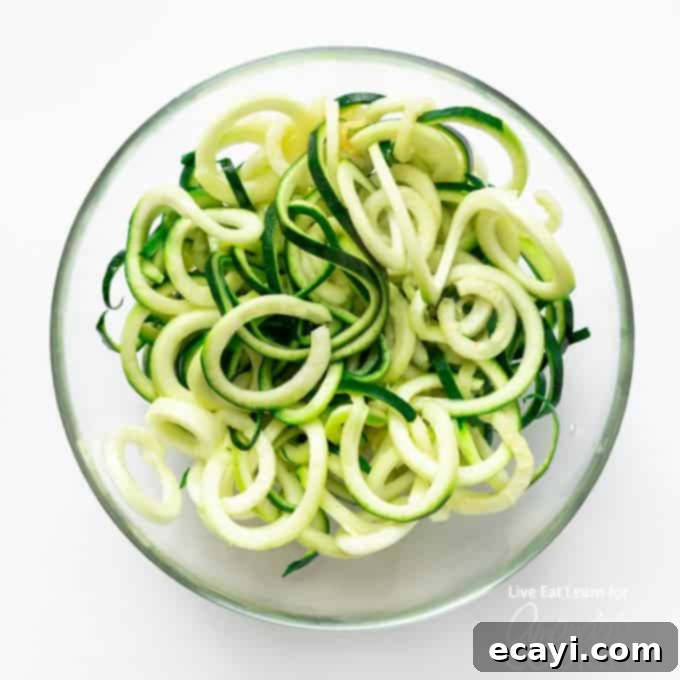How to Make Zucchini Noodles: The Ultimate Guide to Perfect Zoodles Every Time
Zucchini noodles, affectionately known as “zoodles,” have revolutionized healthy eating by offering a fantastic low-carb alternative to traditional pasta. Not only are they incredibly versatile and nutritious, but they’re also surprisingly easy to prepare right in your own kitchen! Forget the heavy, carb-laden feeling after a big bowl of spaghetti; with zoodles, you can enjoy a satisfying meal that’s light, fresh, and bursting with flavor. In this comprehensive guide, we’ll walk you through everything you need to know to transform ordinary zucchini squash into perfectly spiralized veggie deliciousness, complete with essential tips, sauce ideas, and troubleshooting advice.
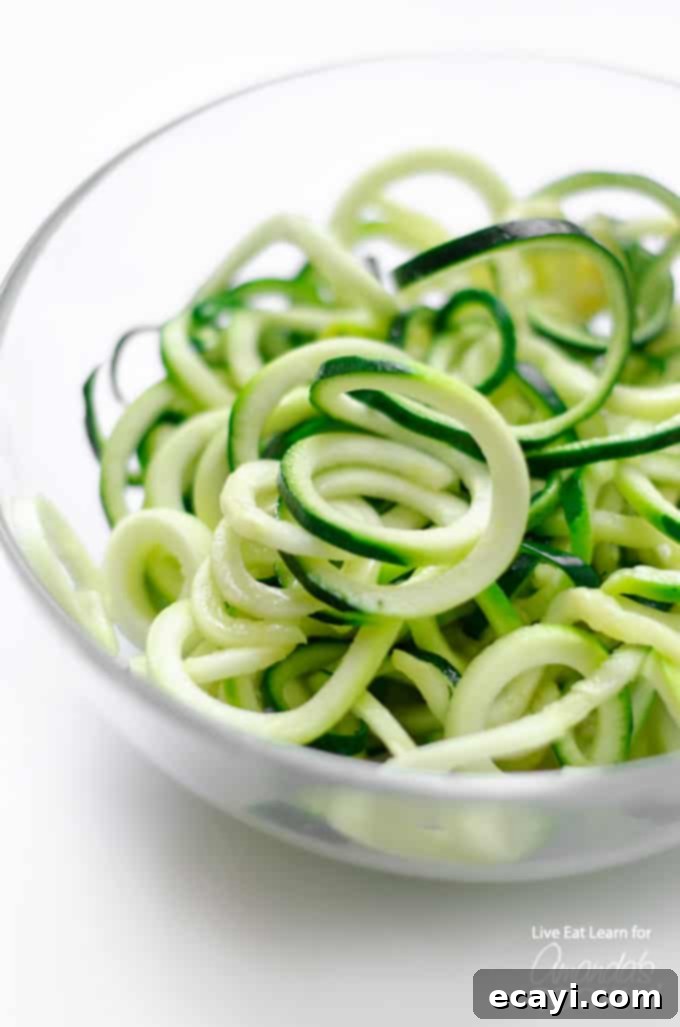
Why Choose Zucchini Noodles? A Healthy and Delicious Alternative
If you haven’t tried making zucchini noodles yet, it’s time to discover what you’ve been missing! Zoodles are more than just a trend; they’re a fun, vibrant, and incredibly healthy substitute for traditional wheat pasta. They bring a unique texture and a mild, fresh flavor to any dish, making them an excellent choice for a variety of dietary needs and preferences.
Unlocking the Health Benefits of Zoodles
- Low-Carb and Keto-Friendly: One of the primary reasons people flock to zucchini noodles is their significantly lower carbohydrate content compared to regular pasta. This makes them an ideal choice for those following ketogenic, paleo, or other low-carb diets, helping to manage blood sugar levels and support weight loss efforts.
- Gluten-Free: For individuals with celiac disease or gluten sensitivity, zucchini noodles offer a naturally gluten-free pasta experience without compromising on taste or texture.
- Rich in Nutrients: Zucchini itself is a powerhouse of essential vitamins and minerals. It’s an excellent source of Vitamin C, Vitamin K, and manganese, along with a good amount of Vitamin B6, folate, and potassium. Plus, it’s packed with antioxidants, promoting overall health and well-being.
- Hydrating and Fiber-Rich: Zucchini has a high water content, contributing to hydration, and it’s also a good source of dietary fiber. Fiber is crucial for digestive health, helping to regulate bowel movements and keep you feeling full and satisfied.
- Versatile and Customizable: From savory to spicy, creamy to light, zucchini noodles can adapt to almost any flavor profile. They are a fantastic canvas for a myriad of sauces and toppings, allowing for endless culinary creativity.
Zucchini is a wonderfully versatile veggie in the kitchen. Beyond zoodles, you can enjoy our popular Zucchini Boats, packed with lean ground turkey, fresh peppers, onions, and grated cheese for a satisfying dinner. For a crunchy side dish, try these Crispy Zucchini Fries – a low-carb alternative to regular fries that certainly aren’t lacking in the flavor department!
Choosing and Preparing Your Zucchini for Perfect Noodles
The journey to perfect zucchini noodles begins with selecting the right zucchini. Look for firm, bright green zucchini that are free of blemishes. Medium-sized zucchini (about 6-8 inches long) tend to be the best for spiralizing, as larger ones can be overly watery and have larger seeds, which can make for less desirable noodles. You’ll want about one medium zucchini per person if serving as a main course.
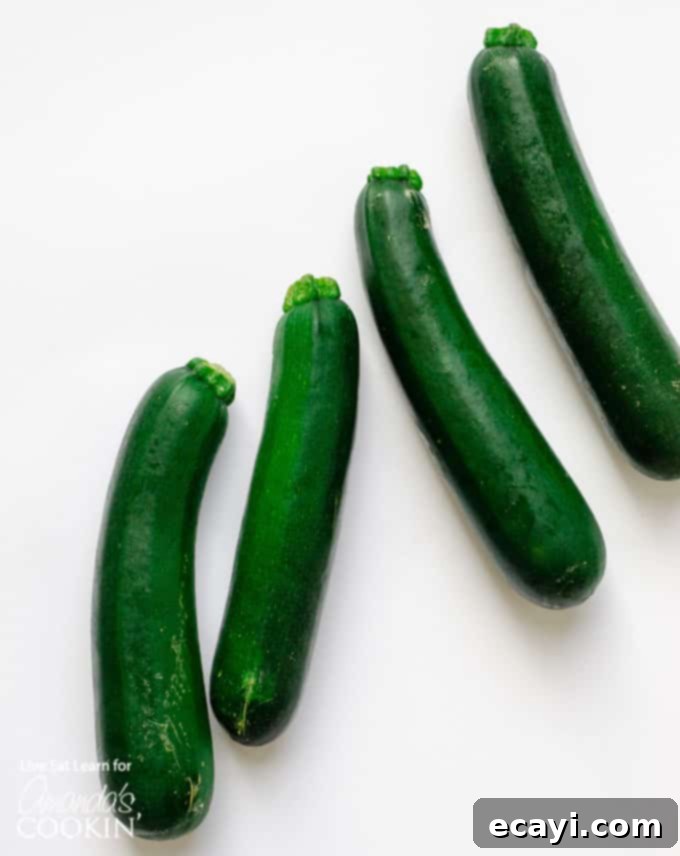
Essential Kitchen Tools You May Find Helpful:
To embark on your zoodle-making adventure, you’ll need a few key tools:
- Spiralizer: This is the star of the show!
- Countertop Spiralizer: These typically offer more stability and different blade options for various noodle shapes and sizes. They are great if you plan to make zoodles frequently or in larger batches.
- Handheld Spiralizer: More compact and budget-friendly, these are perfect for smaller batches and kitchens with limited space. While they might require a bit more manual effort, they still produce excellent noodles.
- Alternatives: If you don’t have a spiralizer, you can still make zoodles with a julienne peeler, a mandoline slicer (with a julienne setting), or even a regular vegetable peeler to create wider, ribbon-like pasta.
- Sauté Pan: A large sauté pan is ideal for cooking your zucchini noodles quickly and evenly. Non-stick or cast iron pans work wonderfully.
- Chef’s Knife: A sharp knife is essential for cleanly trimming the ends of the zucchini and cutting them to size for the spiralizer.
- Cutting Board: A sturdy cutting board provides a safe surface for all your prep work.
- Colander: Absolutely crucial for draining excess water from your zoodles before cooking.
How to Make Zucchini Noodles: A Step-by-Step Guide
Making zoodles is a straightforward process, but a few key techniques will ensure you get the best results.
- Wash and Trim: Begin by thoroughly washing your zucchini under cold water. Pat them dry. Using a chef’s knife, carefully cut off both ends of each zucchini. If your zucchini are particularly long, cut each one in half crosswise. This makes them easier to handle and ensures they fit properly into your spiralizer.
- Spiralize with Care: Place a zucchini half onto the prongs of your spiralizer, ensuring it is perfectly centered. This helps create uniform, long noodles. Apply constant, steady pressure as you turn the handle (for countertop models) or twist the zucchini (for handheld models). The goal is to create continuous, unbroken strands. Don’t worry if you get some shorter pieces; they’re just as delicious!
- The Crucial Draining Step: Zucchini naturally holds a lot of water, which can lead to soggy noodles if not addressed. This step is vital for achieving the perfect texture. Place your freshly spiralized zucchini noodles in a colander. Sprinkle them generously with a pinch or two of salt (about ½ teaspoon per 2 medium zucchini). Gently toss to distribute the salt. Let the noodles sit in the colander for at least 15-20 minutes. The salt will draw out excess moisture. You’ll see a puddle of water collecting underneath – that’s exactly what you want!
- Rinse and Pat Dry (Optional but Recommended): After draining, some people prefer to quickly rinse the noodles under cold water to remove any residual salt, especially if you’re sensitive to sodium. If you do rinse, make sure to pat them thoroughly dry with paper towels to remove any remaining surface moisture. This step is key to preventing them from becoming watery when cooked.
- Cooking Your Zucchini Noodles:
I highly recommend sautéing your zucchini noodles rather than boiling them. Boiling will inevitably turn them into a soggy, limp heap of sadness, losing their appealing texture. Sautéing, on the other hand, preserves their slight crunch and vibrant color.
Heat a large sauté pan over medium-high heat with a splash of olive oil (about 1 tablespoon per 4 zucchini). Once the oil is shimmering, add the drained and patted-dry zucchini noodles. Cook for just 3 to 5 minutes, tossing frequently with tongs. You want them to be bright green and slightly tender, still with a bit of “bite” (al dente). Be careful not to overcrowd the pan, as this can steam the noodles instead of sautéing them. Cook in batches if necessary. The minimal cooking time is key to their delightful texture!
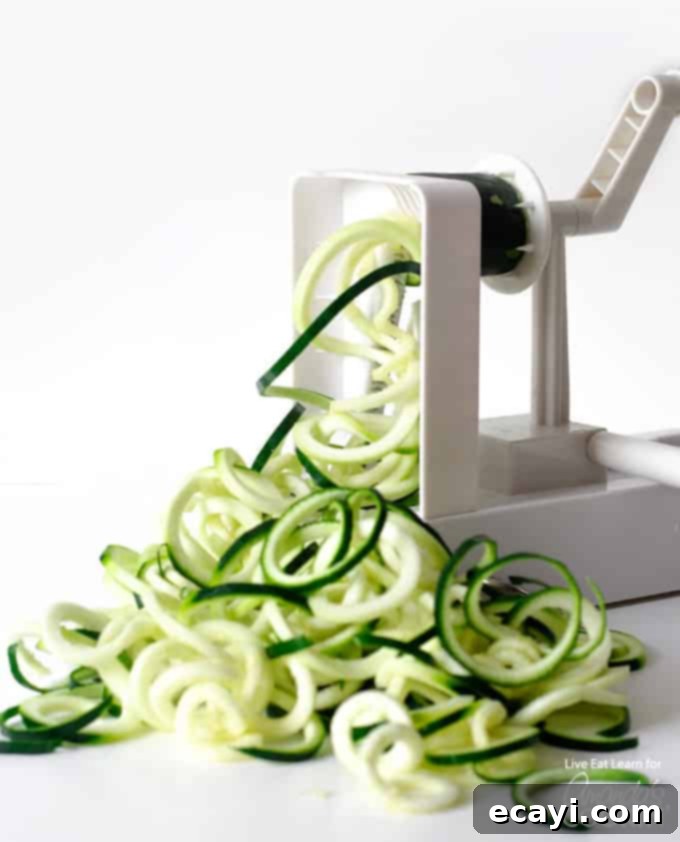
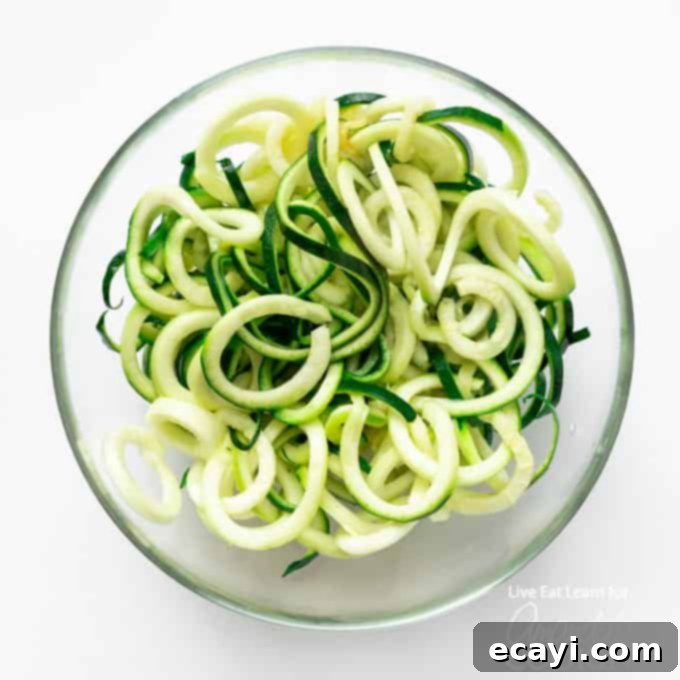
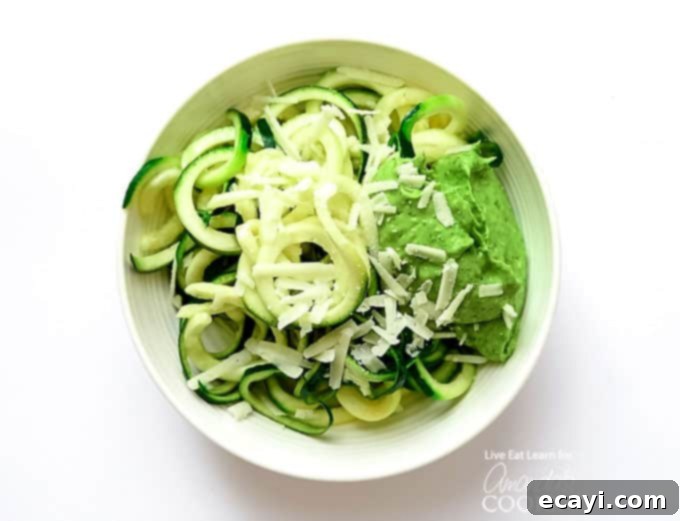
And that’s it! We love finding low-carb ways to make delicious food without skimping on the flavors. Take our Cauliflower Pizza Crust for example. Low-carb has never tasted so good!
Perfect Pairings: Sauces and Toppings for Your Zoodles
Once your zucchini noodles are cooked to perfection, it’s time to elevate them with your favorite sauces and toppings. The beauty of zoodles is their mild flavor, which allows them to perfectly complement a wide array of ingredients.
Our Favorite Sauce Ideas:
- Avocado Pesto Sauce: Today we’re featuring a creamy and nutritious avocado pesto sauce. Its rich, buttery texture and fresh herb flavor blend beautifully with the light zucchini noodles.
- Traditional Pesto: A classic choice! Basil pesto with pine nuts, parmesan, garlic, and olive oil is always a winner with zoodles.
- Marinara Sauce: A simple, vibrant tomato marinara sauce is a healthy and comforting option. Add some ground turkey or lean beef for a heartier meal.
- Romesco Sauce: This Spanish sauce, made with roasted red peppers, tomatoes, garlic, and nuts, adds a smoky, sophisticated flavor.
- Creamy Alfredo or Carbonara: For a more indulgent experience, toss your zoodles with a lightened-up Alfredo or Carbonara sauce.
- Peanut Sauce: Transform your zoodles into an Asian-inspired dish with a savory peanut sauce, often found in stir-fries. Add some shredded carrots and bell peppers for extra crunch.
- Lemon Garlic Butter: A simple yet elegant sauce that highlights the freshness of the zucchini. Sauté garlic in butter, add lemon juice, and a sprinkle of fresh herbs like parsley or dill.
- Curry Sauce: For an exotic twist, warm up your favorite mild or spicy curry sauce and toss it with the cooked zoodles.
Enhance Your Meal with Toppings:
- Proteins: Grilled chicken, sautéed shrimp, baked salmon, crispy tofu, or lean ground meat all pair wonderfully.
- Fresh Vegetables: Cherry tomatoes, bell peppers, spinach, mushrooms, and asparagus add color, texture, and nutrients.
- Cheese: A sprinkle of grated Parmesan, crumbled feta, or fresh mozzarella can add a delightful touch.
- Herbs and Spices: Fresh basil, cilantro, oregano, red pepper flakes, or a dash of black pepper can elevate the flavor.
- Nuts and Seeds: Toasted pine nuts, chopped walnuts, or sesame seeds can add a satisfying crunch.
Beyond Pasta: Creative Uses for Zucchini Noodles
While zoodles excel as a pasta substitute, their versatility doesn’t end there! Explore these alternative ways to incorporate them into your meals:
- Cold Zoodle Salads: Toss raw zucchini noodles with a light vinaigrette, cherry tomatoes, cucumbers, and fresh herbs for a refreshing summer salad. They hold up beautifully and offer a delightful crunch.
- Stir-Fries: Add zoodles to your favorite stir-fry recipe in the last few minutes of cooking. They absorb the flavors of the sauce and add a lovely texture.
- Soups: Instead of traditional noodles, drop zucchini noodles into hot broth or soup during the last minute of cooking to warm them through. This keeps them from getting mushy and adds a healthy boost to your soup.
- Side Dish: Simply sautéed with a little garlic and olive oil, zoodles make a quick and healthy side dish for almost any main course.
FAQs and Troubleshooting Tips for Zucchini Noodles
Even though zoodles are straightforward to make, you might encounter a few common issues. Here are some FAQs and tips to ensure success every time:
1. Why are my zucchini noodles watery or soggy?
This is the most common issue! Zucchini is full of water. The key to preventing soggy zoodles is the salting and draining step. Don’t skip it! Sprinkle with salt, let them sit in a colander for 15-20 minutes, then gently squeeze or pat them dry with paper towels before cooking. Overcooking also leads to sogginess, so stick to quick sautéing.
2. How can I prevent my zoodles from getting mushy?
The solution lies in proper cooking. Avoid boiling zoodles, as they will quickly turn mushy. Sauté them quickly over medium-high heat for just 3-5 minutes until they are bright green and slightly tender-crisp. They should still have a little bite to them (al dente). Undercooking them slightly is better than overcooking.
3. Can I make zucchini noodles without a spiralizer?
Absolutely! While a spiralizer is the easiest tool, you can use:
- Julienne Peeler: This tool creates thin, matchstick-like strips that resemble noodles.
- Mandoline Slicer: If your mandoline has a julienne blade attachment, it will work wonderfully. Use caution and a food guard!
- Vegetable Peeler: For wide, ribbon-like “pappardelle” style noodles, simply run a vegetable peeler lengthwise down the zucchini.
- Chef’s Knife: With a steady hand, you can carefully slice the zucchini into thin planks, then stack and slice them into thin strips.
4. Can I eat zucchini noodles raw?
Yes, you can! Raw zucchini noodles are fantastic in cold salads or as a crunchy base for lighter sauces. If eating raw, the salting and draining step is still beneficial to reduce excess water and improve texture.
5. What’s the best type of zucchini to use?
Medium-sized zucchini (about 6-8 inches long) are generally preferred. They have a good flesh-to-seed ratio and are less watery than very large zucchini. Smaller zucchini can be harder to spiralize efficiently.
6. How do I store fresh and cooked zucchini noodles?
Fresh Zoodles: If you spiralize them ahead of time, store them in an airtight container lined with paper towels in the refrigerator for 2-3 days. The paper towels will absorb any moisture.
Cooked Zoodles: Cooked zoodles are best enjoyed immediately. If you have leftovers, store them in an airtight container in the fridge for up to 1-2 days. Be aware they will become softer and release more water upon reheating. Reheat gently in a sauté pan rather than microwaving for best results.
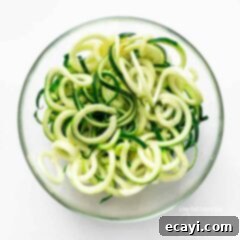
How to Make Zucchini Noodles
IMPORTANT – There are often Frequently Asked Questions within the blog post that you may find helpful. Simply scroll back up to read them!
Print It
Rate It
Save ItSaved!
Ingredients
For the Zucchini Noodles
- 4 medium zucchinis
- Pinch of salt (for draining)
- 1 Tbsp olive oil (for sautéing)
For the Avocado Pesto Sauce (Optional)
- 1 avocado skin removed, pitted
- 1 clove garlic
- ½ cup fresh basil leaves packed
- 1 Tbsp lemon juice
- 2 Tbsp extra virgin olive oil
Instructions
-
Wash and trim both ends off each zucchini. If the zucchini are long, cut them in half to ensure they fit securely into your spiralizer. Place a zucchini half in your spiralizer so it’s perfectly centered, then apply constant, steady pressure while turning to create long, uniform zucchini noodles. Repeat with remaining zucchini.
-
Place the spiralized zucchini noodles in a colander and sprinkle them generously with a pinch of salt. Allow them to sit for 15-20 minutes to draw out excess water. Optionally, after draining, you can gently pat them dry with paper towels to remove any remaining moisture and salt.
-
Heat 1 tablespoon of olive oil in a large saute pan over medium-high heat. Add the drained zucchini noodles and cook for only 3 to 5 minutes, tossing frequently, until they are bright green and slightly tender-crisp (al dente). Be careful not to overcook them to prevent sogginess.
-
Serve your perfectly cooked zucchini noodles immediately with your favorite pasta sauce, protein, or toppings.
-
To prepare the delicious Avocado Pesto Sauce shown in the pictures, combine the following ingredients in a food processor: 1 pitted and peeled avocado, 1 clove garlic, ½ cup fresh basil leaves, 1 tablespoon lemon juice, and 2 tablespoons extra virgin olive oil. Blend until smooth and creamy.
Nutrition
The recipes on this blog are tested with a conventional gas oven and gas stovetop. It’s important to note that some ovens, especially as they age, can cook and bake inconsistently. Using an inexpensive oven thermometer can assure you that your oven is truly heating to the proper temperature. If you use a toaster oven or countertop oven, please keep in mind that they may not distribute heat the same as a conventional full sized oven and you may need to adjust your cooking/baking times. In the case of recipes made with a pressure cooker, air fryer, slow cooker, or other appliance, a link to the appliances we use is listed within each respective recipe. For baking recipes where measurements are given by weight, please note that results may not be the same if cups are used instead, and we can’t guarantee success with that method.
This post was originally published here on April 6, 2019, and has been updated with more comprehensive information and tips for the best zucchini noodle experience.
